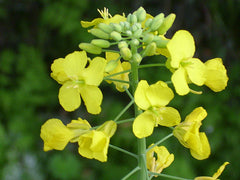Foeniculum vulgare, Fennel Common
Soft feathery green foliage, makes an excellent filler plant in the herbaceous border.
Edible seeds aid digestion, leaf can be used as garnish. 150cm
Especially in mild winters, the leaves can be available all year round.
It is best to cut a few plants back to ground level occasionally during the growing season, thus ensuring a constant supply of fresh young shoots. In a dry summer make sure that you water the cut-down clump or it might not regrow that year. Fennel is also grown commercially as a medicinal plant and for its essential oil.
Fennel is in general a poor companion plant in the garden. It inhibits the growth of nearby plants, especially beans, tomatoes and kohl rabi. It is itself inhibited by wormwood and coriander. However, the flowering plant attracts beneficial insects such as bees, parasitic wasps, tachinid flies and hoverflies to the garden. The presence of these creatures will help to maintain a natural balance of insects in the garden and help prevent infestations by aphis etc.
It is best not to grow fennel and dill (Anethum graveolens) close to each other since hybridisation can occur and the resulting seedlings will be of indeterminate flavour.
Fennel has a long history of herbal use and is a commonly used household remedy, being useful in the treatment of a variety of complaints, especially those of the digestive system.
Yellow and brown dyes are obtained from the flowers and leaves combined.
An easily grown plant, it succeeds in most soils but prefers a sunny dry position. It grows well in sandy soils and is drought tolerant once established. Plants often self-sow freely in the garden. Plants can be grown in quite coarse grass, which can be cut annually in the autumn.
Best sown in early spring in situ. The seed can also be sown in situ in the autumn. In many gardens it self sows freely.
Edible usesLeaves - raw or cooked. A delicious aniseed flavour, the young leaves are best since older ones soon become tough. They are often used as a garnish on raw or cooked dishes and make a very pleasant addition to salads. They help to improve digestion and so are particularly useful with oily foods. The leaves are difficult to store dried, though this does not really matter since they can often be harvested all year round, especially if the plants are in a warm, sheltered position.
Leaf stalks and flower heads - raw or cooked. A similar aniseed flavour to the leaves. The aromatic seeds are used as a flavouring in cakes, bread, stuffings etc. They have a similar flavour to the leaves and also improve the digestion. The sprouted seeds can be added to salads. An essential oil from the fully ripened and dried seed is used as a food flavouring in similar ways to the whole seed.
Root - cooked. Somewhat parsnip-like.
The leaves or the seeds can be used to make a pleasant-tasting herbal tea.http://practicalplants.org/wiki/Foeniculum_vulgare








